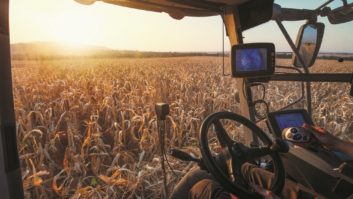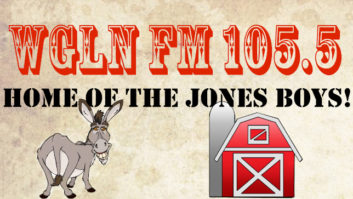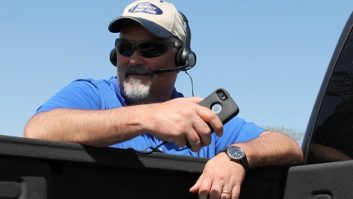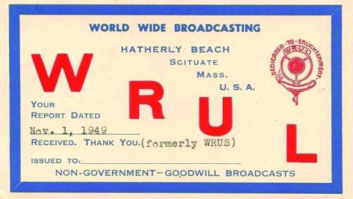(click thumbnail)Eric Brown. He is standing next to the statue ‘Breaking News,’ which noted KRVN’s 50th anniversary in 2001 and is ‘dedicated to the farm and ranch families who tune their radios to KRVN, KNEB and KTIC for weather, markets, agricultural news and entertainment.’You might not know much about soybeans, heifers or pork bellies. But these topics are vital to the farmers of Nebraska.
Eric Brown and his group of radio stations specifically target people with an interest in agribusiness in that state, a $10 billion industry.
Brown’s father Max started KRVN(AM), Lexington in 1951, in part because of the blizzards of late 1948 and early 1949. Area farmers were unable to get timely weather information, and as a result, human lives and livestock were lost. Max Brown believed that better communication in this thinly populated area was essential.
Eric Brown became station manager in 1979. Since that time he has added an FM and four other stations across the state. All provide information and a sense of community to his farming audience.
“We have a niche,” he said. “It’s old-fashioned, full-service radio. But we have updated it by having Web sites that get up to a million page views each month. The population of Nebraska is pretty small, so the Internet is a great equalizer for rural people. They can access our information and make purchases without having to drive long distances.”
Brown believes that in time, his Internet billing will equal his traditional revenue.
(click thumbnail)This year’s summer promotion, Teammate Tailgate. KRVN staff travels across Nebraska attending almost 100 fairs, rodeos, parades, open houses and summer celebrations. This year’s winner got to drive home a bright red, new Dodge Dakota.“You have to realize that out here people are not listening in 75-story office buildings,” he said. “They’re in these small communities listening on farms and in their pick-ups. The Internet is so important to us that we launched a service that builds customized Web sites for our advertisers. We are in the information business, not just the radio business.”
The station’s Web site, www.krvn.com, offers more than the expected market reports, weather and news. There are podcasts of interviews and features, opportunities for people to buy and sell equipment, school lunch menus, guided trips and tours that listeners can take around the state and elsewhere, funeral announcements, photos of state fairs and tailgate parties, local sports calendars and more.
Ads on this Web site are not “giveaways” for advertisers as they are on some stations. Fixed positions on the site are sold at a premium.
(click thumbnail)The station’s original home. The front half was an apartment building, the back was a mortuary. Brown says that’s why he still worries about dead air.Reaching out, touching you
There are 30 full-time and eight part-time employees at KRVN(AM/FM), which is a high level of staffing by anyone’s standards. This includes a couple of 26-year-old computer gurus whose identities Brown wants kept under wraps.
“It’s like they’re in the KRVN witness protection program,” he said. “They are very good at what they do and we don’t want to lose them.”
In addition to KRVN and its FM, “River 93,” station engineers also service KNEB(AM/FM), Scottsbluff, 200 miles west of Lexington; and KTIC(AM)/KWPN(FM), West Point, 200 miles to the east. All are owned by Nebraska Rural Radio Association (NRRA). But this is not your typical group owner. NRRA comprises 4,200 farmers and ranchers with a nine-person board of directors. Brown serves as secretary treasurer.
“Our owners give us input by e-mail and letters or occasionally they’ll pick up the phone if there is something important to talk about,” said Brown. “We hold focus groups with young farmers and conduct audience research using a Sioux Falls company called Ag Media Research. We are really in touch with the farming community all over the state.”
In 2005, Brown helped set up Rural Lifestyle Marketing LLC, a loose confederation of stations across the upper Midwest, and he serves as president. The purpose of the group is to band together to sell advertising to clients who wish to reach the agribusiness market.
A bit of history
In 2001, Eric Brown’s flagship station marked a half century of broadcasting with the publication of a commemorative paperback, “KRVN: The First 50 Years of Service to Agriculture,” by Max, Eric and Ruth Brown. Ruth is married to Eric and is an associate professor of communications at the University of Nebraska at Kearney.
The book is rich with that sense of history. For example, the station was initially capitalized with $50,000, collected from almost 5,000 people at $10 each. By its charter, profits from the station cannot revert to the owners. They are to be used first for better radio facilities and programming, and secondly for agricultural education, rural youth and the College of Agriculture.
(click thumbnail)Dick ‘Noodle Soup’ Klasi and his accordion.
Other highlights from the book: KRVN signed on as a day-timer at 1010 on the dial. In 1972 it received FCC approval to kick up its power to 50,000 watts and switch to 880 kHz. Live music filled a big part of the broadcast day with the likes of Dick “Noodle Soup” Klasi and his accordion, Doc and Esther Embree on guitar and piano and Polka Paul and his Band. Other colorful entertainers on the KRVN airwaves included Walt Shrum and the Westernaires, Harry Evans and the Rhythm Wranglers and Jack Lloyd and the Happy Tones. There are archival photos of remote broadcasts from the Omaha Grain Exchange and other local spots of importance.
The book is available through the station, and while much has changed since 1951, the hallmarks of KRVN remain constant: agricultural news and more accurate weather for the farmers.
In 2008, it is hard to find and train good employees, but it is even more difficult to find new blood in one of the most sparsely populated states of the union.
“It’s a constant search process,” said Brown. “We want people who enjoy a rural lifestyle with good schools, clean air and a nice environment for families. We pay pretty well, but I think our benefits package is far better than most of the stations in the Midwest. It includes a defined benefit retirement plan and an optional 401(k) plan, items only about 10 percent of the businesses in the country have anymore.”
Brown is taking steps in other directions as well.
“I was just elected to the board of the National Association of Broadcasters,” he said. “And we in Nebraska lobby our congressional delegation every year. There are now more issues than ever, including the music royalty tax that some folks want to put on us.”
As for the future, Brown is sure that the Internet in general, and podcasts in specific, will be even more important to his farming audience. But as to whether terrestrial radio will ever be replaced, he is unsure.
“My crystal ball just doesn’t go that far.”















